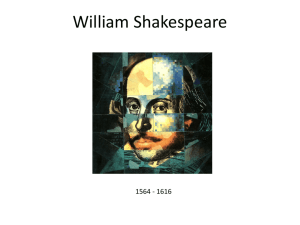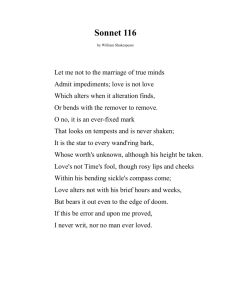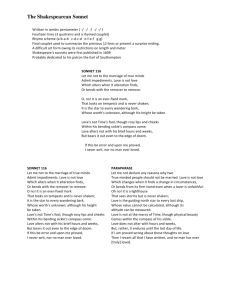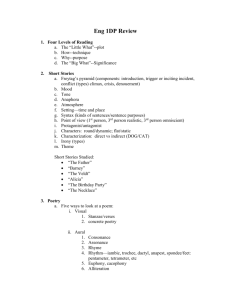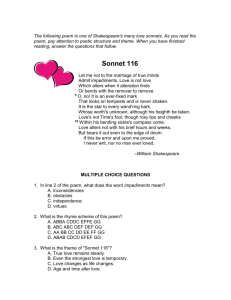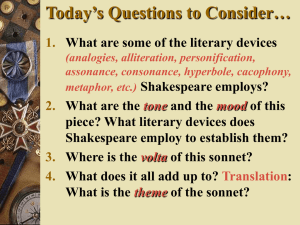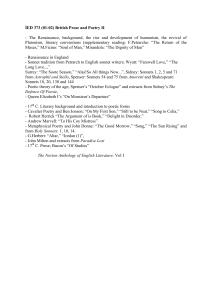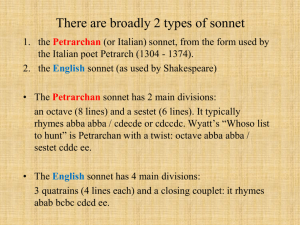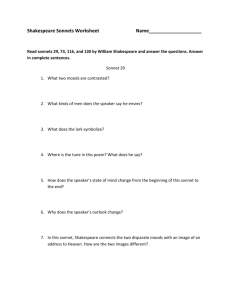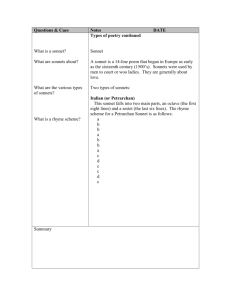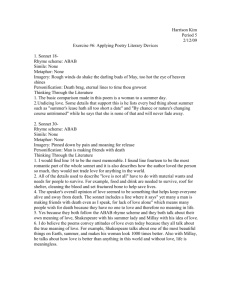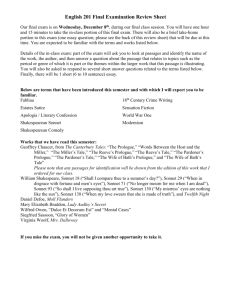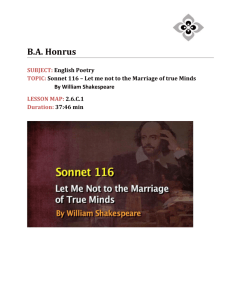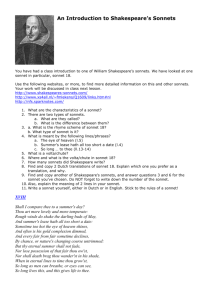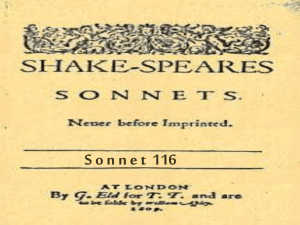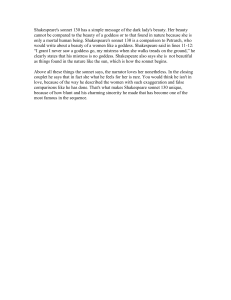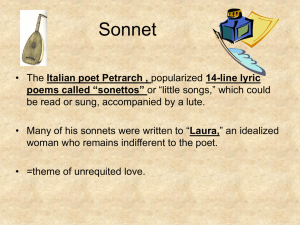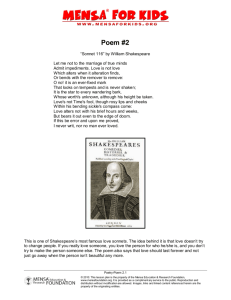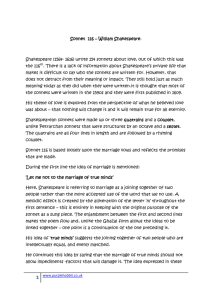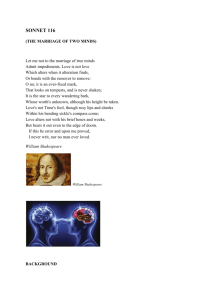The Sonnet Background Two types of sonnets
advertisement
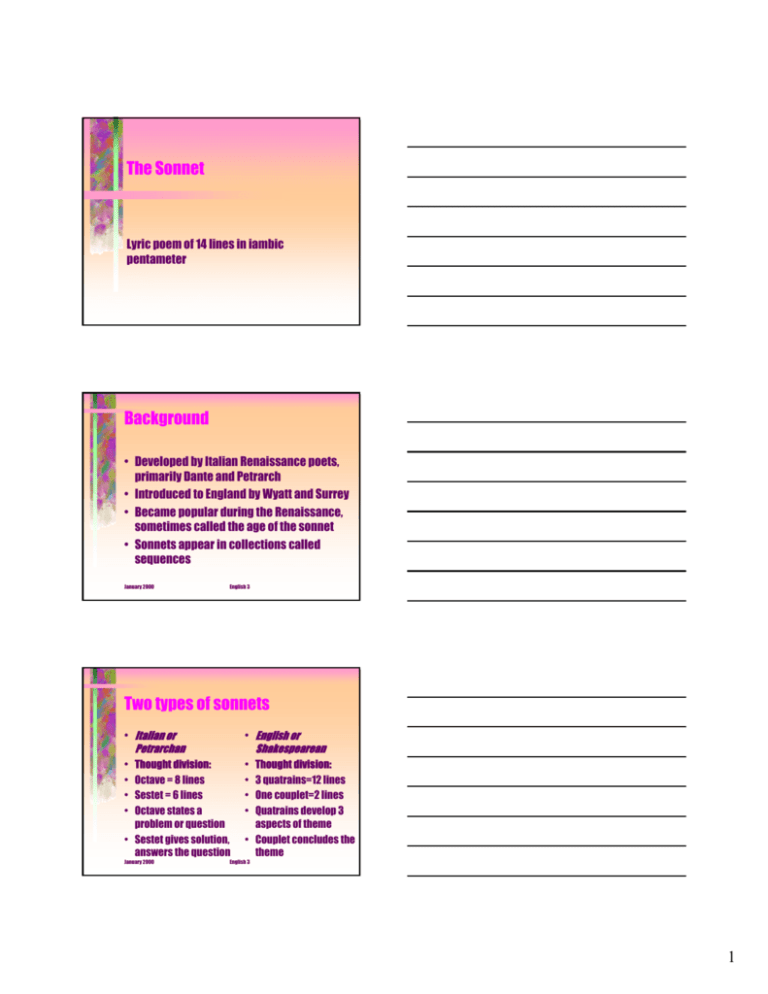
The Sonnet Lyric poem of 14 lines in iambic pentameter Background • Developed by Italian Renaissance poets, primarily Dante and Petrarch • Introduced to England by Wyatt and Surrey • Became popular during the Renaissance, sometimes called the age of the sonnet • Sonnets appear in collections called sequences January 2000 English 3 Two types of sonnets • Italian or • English or • • • • • • • • Petrarchan Shakespearean Thought division: Octave = 8 lines Sestet = 6 lines Octave states a problem or question • Sestet gives solution, answers the question January 2000 Thought division: 3 quatrains=12 lines One couplet=2 lines Quatrains develop 3 aspects of theme • Couplet concludes the theme English 3 1 Two types of sonnets • Italian or • English or • Rhyme scheme: • ABBA, ABBA • CDE, CDE • Rhyme scheme: • ABAB, CDCD, EFEF • GG Petrarchan Shakespearean Many sonnets do not follow a perfect rhyme scheme Slight variations are common January 2000 English 3 Theme • The most popular theme of Renaissance sonnets is love, especially unrequited love January 2000 English 3 Theme • Unrequited means that the love is not returned • The beloved is admirable but unattainable • The lover suffers • The circumstances of life fade beside affection • This is a convention of love poetry January 2000 English 3 2 Shakespeare’s Sonnet 116 Let me not to the marriage of true minds Admit impediments. Love is not love Which alters when it alteration finds, Or bends with the remover to remove. January 2000 English 3 Shakespeare’s Sonnet 116 Oh no! It is an ever-fixed mark, That looks on tempests and is never shaken; It is the star to every wandering bark, Whose worth’s unknown, although his height be taken. January 2000 English 3 Shakespeare’s Sonnet 116 Love’s not Time’s fool, though rosy lips and cheeks Within his bending sickle’s compass come; Love alters not with his brief hours and weeks, But bears it out even to the edge of doom. January 2000 English 3 3 Shakespeare’s Sonnet 116 If this be error and upon me proved, I never writ, nor no man ever loved. January 2000 English 3 Vocabulary • Impediment – obstacle January 2000 English 3 Vocabulary • Ever-fixed mark – reference point January 2000 English 3 4 Vocabulary • Bark – three-masted ship – boat, ship January 2000 English 3 Vocabulary • Sickle – agricultural tool with a curved metal blade and a short handle, used for cutting – a sickle is similar to a scythe but a scythe has a long handle January 2000 English 3 Figures of Speech It is an ever-fixed mark, That looks on tempests and is never shaken Metaphor comparing love to a landmark Meaning: true love is reliable and unchanging January 2000 English 3 5 Figures of Speech It is the star to every wandering bark, Whose worth’s unknown, although his height be taken. Metaphor comparing love to a star Meaning: true love can always be relied upon for guidance, but no value can be attached to it January 2000 English 3 Figures of Speech Love’s not Time’s fool, though rosy lips and cheeks Within his bending sickle’s compass come; Metaphor comparing time to a reaper who cuts grain with a sickle Meaning: time destroys youth and beauty, (but true love doesn’t change with time) January 2000 English 3 6
